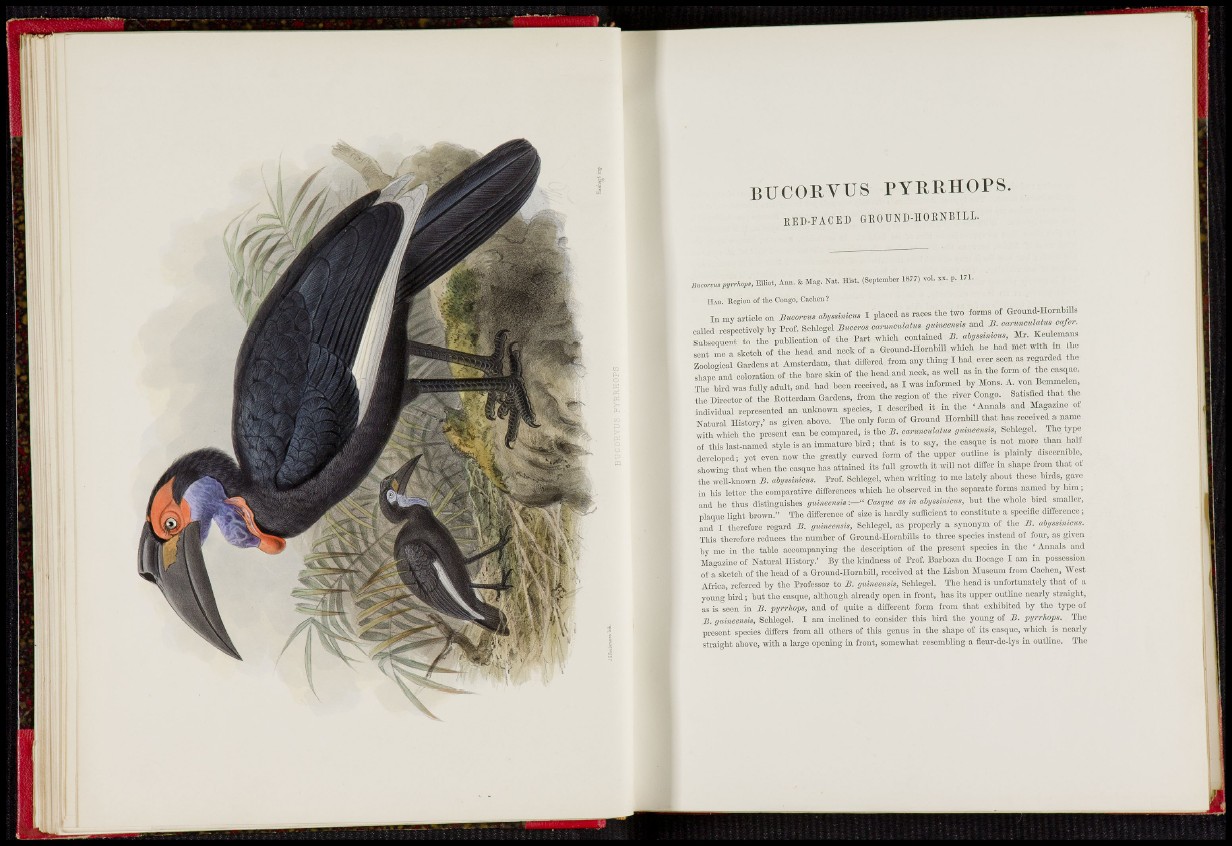
BUCORVÜS PYREHOPS.
KED-FACED GEOtlKE-HOKNBILL.
«.„„.„„,Tí»,., Effiot, An.. S. M.g. N... Ili.t. (September 1877) vol. xx. 171.
IIAB. Region of the Congo, Cncben?
In my artido on I pl-cod as races tto two forms of GrounMIornbills
oallc rZootivoly by Prof. Soblogol oa,-uncuMu. and «»¡«i« cafir.
t L publication of tbo Part which contained Mr. Koulomans
¡ i t T o a shotch of the head and neck of a Ground-IIornbill which he had met wrth m he
Medical Gar-dens at Amsterdam, that differed from any thing I had oyer seen as regarded the
e° ñd ooleration of the bare skin of the head and nec^, as woU as in the form ef the cas<inc.
i r » ' bird was fnUy adnlt, and had been reeoived, as I was informed by Mens. A^ - n
the Director of the Botterdam Gardens, from the region of the rmr Congo. Satisfied that the
indiridnal represented an nnkno™ species, I described it in the -Annals and Maga^me of
Natural History,' as given aboye. The only form of Ground HornhiU that has rceeiyed a name
with whieh the present ean be compared, is the ii. carumulalm guiñead,, Schlegel. The type
of this last-named stylo is an immature bird; that is to say. the casque is not more than hall
deyeloped- yet even now the gi-eatly eurved form of the upper outline is plainly diseernible,
shewing that when the casque has attained its full growth it will not differ in shape from that of
the well-lmown B. ai,jsm,icm. Prof. Sehlegel, when writing to mo lately about those birds, gave
in his letter the comparative dilferenees whieh he observed in the separate forms named by hjm;
and he thus distinguishes guinemm •.-" Casque m in Mpainicns, but the whole bird smaller,
plaque light brown." The diflcrenee of size is hardly snílícicnt to constitute a specific diffierencc;
and I ttecfore regard IB. gumeemis, Schlegel, as properly a synonym of tho B. ahijminiem.
This therefore reduces tho number of Oround-Hornbills to three species instead of four, as given
by me in the table aceompanying the description of the present specios in tiie ' Annals and
Magazme of Natural History.' By tho kindness of Prof. Barboza du Booago I am in possession
of a sketch of the head of a Ground-nornbill, received at the Lisbon Museum from Oaehen, West
Africa, referred by the Professor to B. guineemis, Sehlegel. The head is unfortunately that of a
young bii-d ; hut the easque, although already open in front, has its upper outline nearly straight,
as is "seen in B. pyrrhofs, and of quite a different form from that exhibited by tho type of
B. guimeims, Sehlegel. I am inclined to consider this bird the young of B. pyrrhofs. The
present species differs from all others of this genus in tho shape of its easque, whieh is nearly
straight above, with a large opening in front, somewhat resembling a fleur-de-lys in outline. The
I